


THE CONSULATE 1799 -
xxxxxAs we have seen, The
Directory was
established in 1795
and, over the next four years, proved a weak and corrupt system of
government. To remain in power it carried out a number of purges to
rid parliament of royalists and counter-
Including:
Napoleon Bonaparte

xxxxxAs we have seen, The
Directory had been established by the National Convention in 1795. Over the next four years
this bourgeois republic proved weak, corrupt and progressively
unpopular. Made up of a five-
 xxxxxAnd the threat of an army take-
xxxxxAnd the threat of an army take-
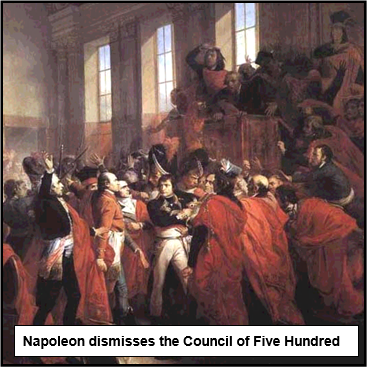 xxxxxThe coup d’état which made
General Bonaparte leader of France, putting an end to The Directory
and, in effect, the French Revolution itself, was engineered in the second week of November
1799 (the coup of 18th Brumaire). With the connivance of Abbé Sieyès
(a member of the Directory) and the support in particular of
Charles-
xxxxxThe coup d’état which made
General Bonaparte leader of France, putting an end to The Directory
and, in effect, the French Revolution itself, was engineered in the second week of November
1799 (the coup of 18th Brumaire). With the connivance of Abbé Sieyès
(a member of the Directory) and the support in particular of
Charles-
xxxxxAt home he began to
introduce a vast programme of reform aimed at quelling dissension
and improving government administration, the country’s financial
situation, and the judicial system -
Acknowledgements
Council of Five Hundred:
by the French painter and engraver François Bouchot (1800-
G3b-
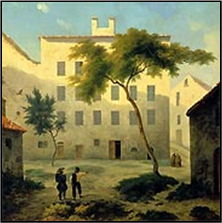
xxxxxNapoleon Bonaparte (1769-
xxxxxThen two years
later, in October 1795, he swiftly crushed a royalist uprising in
Paris, enabling The Directory to begin its four-
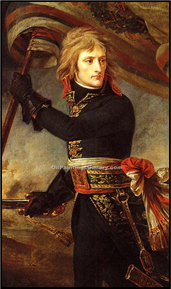 xxxxxIn this campaign he showed not only outstanding ability
as a military tactician and a leader of men, but also consummate
skill as a diplomat, rearranging the map of Italy with little if any
recourse to the government in Paris. In addition, he contributed
substantially to the coffers of The Directory, and the contents of a
number of French museums by purloining vast amounts of money and
confiscating priceless works of Italian art. And such was the
measure of his military success in this secondary theatre that,
having accomplished his task and learnt that the two other French
armies had failed to achieve theirs, he crossed the Alps and
advanced upon the Austrian capital. It is quite possible that he
would have captured the city had not Austria sued for peace!
xxxxxIn this campaign he showed not only outstanding ability
as a military tactician and a leader of men, but also consummate
skill as a diplomat, rearranging the map of Italy with little if any
recourse to the government in Paris. In addition, he contributed
substantially to the coffers of The Directory, and the contents of a
number of French museums by purloining vast amounts of money and
confiscating priceless works of Italian art. And such was the
measure of his military success in this secondary theatre that,
having accomplished his task and learnt that the two other French
armies had failed to achieve theirs, he crossed the Alps and
advanced upon the Austrian capital. It is quite possible that he
would have captured the city had not Austria sued for peace!
xxxxxHe returned to Paris to a hero’s welcome, but with some apprehension on the part of the government itself. Thus in 1798, The Directory, being wary of this highly ambitious republican soldier, willingly gave their consent when he suggested that he should invade Egypt to strike at the colonial power of Great Britain, France’s remaining enemy. At first all went well for him. He captured Malta on route, defeated the Egyptian army at the Battle of the Pyramids, and then went on to capture Cairo. In August, however, a British fleet commanded by Admiral Horatio Nelson, attacked and virtually destroyed his naval force at the Battle of the Nile. Apart from ending his grandiose schemes for colonial conquest, it left his army stranded in Egypt. After leading an unsuccessful invasion into Syria, he managed to win a further battle against the Egyptians at the Battle of Aboukir before evading the British naval blockade and making his way back to France, arriving in October 1799. Here (as we have seen above), he was in time to seize power from The Directory, by then in the throes of disintegration, and establish his own regime, The Consulate. “I found the crown of France lying on the ground”, he later remarked, “and I picked it up with a sword.”
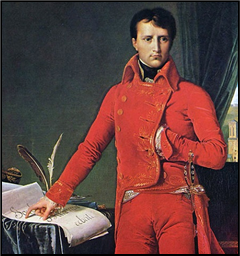 xxxxxOnce firmly in office and wielding dictatorial powers
behind a republican façade (illustrated), Napoleon turned his
attention to internal as well as external matters. In the interests
of greater harmony at home, for example, he reconciled the
royalists, pacified regions still harbouring grievances, and, in
1801, ended the breach with the Roman Catholic Church by a Concordat
reached with Pope Pius VII. At the same time, he began a thorough
overhaul of the country’s administration, balancing the budget,
introducing a fairer method of taxation, centralising local
government, and providing the means for higher education. And to
this period belonged the drafting of the Napoleonic Code -
xxxxxOnce firmly in office and wielding dictatorial powers
behind a republican façade (illustrated), Napoleon turned his
attention to internal as well as external matters. In the interests
of greater harmony at home, for example, he reconciled the
royalists, pacified regions still harbouring grievances, and, in
1801, ended the breach with the Roman Catholic Church by a Concordat
reached with Pope Pius VII. At the same time, he began a thorough
overhaul of the country’s administration, balancing the budget,
introducing a fairer method of taxation, centralising local
government, and providing the means for higher education. And to
this period belonged the drafting of the Napoleonic Code -
xxxxxOn the military
front (see map below), he set out to reassert French supremacy. As
we shall see, his defeat of the Austrians at the Battle of Marengo
in June 1800,
together with the success achieved by a French army serving in
Germany, brought about the collapse of the Second Coalition. By the
Treaty of Luneville
in February 1801 Austria was obliged to recognise France’s natural
boundaries -
xxxxxThat same year he was made
First Consulate for life and then, as we shall see, was crowned Emperor of
the French in 1804 (G3c)
with the overwhelming support of the people. Having founded a royal
dynasty, he then embarked on the conquest of Europe by means of the
aptly-
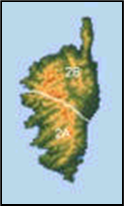 xxxxxIncidentally, for a time
Napoleon’s father, Carlo supported the nationalist leader Pasquale Paoli in his bid to
gain independence for Corsica, then ruled by Genoa, but gave his
allegiance to the French when they took over the island in 1769.
Later, Napoleon himself opposed Paoli when, leading a revolt against
the French in the early 1790s, he managed to turn the island over to
the British, though only for a couple of years. You might recall
that the Scottish biographer James Boswell, visited Corsica during
his tour of the continent and, after meeting Paoli, published his Account of Corsica in 1768 to rally support
for the nationalist cause. ……
xxxxxIncidentally, for a time
Napoleon’s father, Carlo supported the nationalist leader Pasquale Paoli in his bid to
gain independence for Corsica, then ruled by Genoa, but gave his
allegiance to the French when they took over the island in 1769.
Later, Napoleon himself opposed Paoli when, leading a revolt against
the French in the early 1790s, he managed to turn the island over to
the British, though only for a couple of years. You might recall
that the Scottish biographer James Boswell, visited Corsica during
his tour of the continent and, after meeting Paoli, published his Account of Corsica in 1768 to rally support
for the nationalist cause. ……
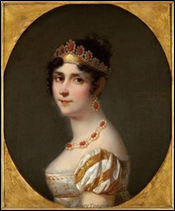 xxxxx…… Napoleonxmarried Josephine de
Beauharnais in 1796. Widow of General de
Beauharnais, and the then mistress of Vicomte de Barras, (a member
of the Directory), she was an ambitious, attractive woman, well
known in Parisian society. She possibly married Napoleon to gain a
degree of security. At first, she seems to have regarded him as a
quaint little Corsican, but she had to make a quick reappraisal when
he returned from his triumphant Italian campaign. Their married life
together appears to have been quite a happy one and, as we shall
see, she was eventually crowned Empress of the French in 1804 (G3c). Five years later,
however, failing to produce an heir for the new dynasty, Napoleon
was obliged to divorce her. He then married into the prestigious
Austrian House of Habsburg and begot the son he so badly needed. ……
xxxxx…… Napoleonxmarried Josephine de
Beauharnais in 1796. Widow of General de
Beauharnais, and the then mistress of Vicomte de Barras, (a member
of the Directory), she was an ambitious, attractive woman, well
known in Parisian society. She possibly married Napoleon to gain a
degree of security. At first, she seems to have regarded him as a
quaint little Corsican, but she had to make a quick reappraisal when
he returned from his triumphant Italian campaign. Their married life
together appears to have been quite a happy one and, as we shall
see, she was eventually crowned Empress of the French in 1804 (G3c). Five years later,
however, failing to produce an heir for the new dynasty, Napoleon
was obliged to divorce her. He then married into the prestigious
Austrian House of Habsburg and begot the son he so badly needed. ……

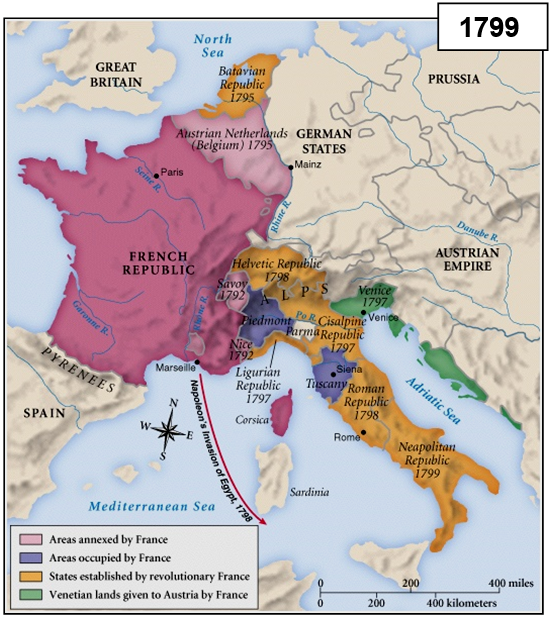
…… In 1802 Napoleon instituted the Order of the Legion of Honour, to be conferred upon any man, woman (including foreigners) for meritorious service to the state in civil as well as military life. When awarded in connection with war service, it carries with it the Croix de Guerre, the highest military medal. ……
xxxxx……
The above portrait of Napoleon as the First Consul was the work of
the French neo-
xxxxxNapoleon Bonaparte (1769-


